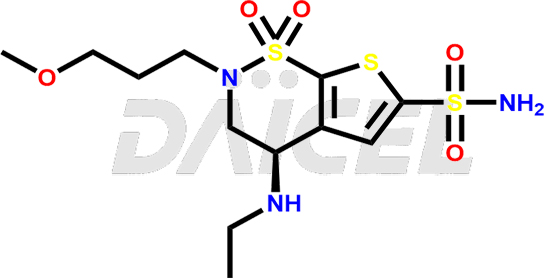LOAD MORE
You're viewed 9 of 11 products
Daicel Pharma synthesizes Brinzolamide impurities of exceptional quality, such as Methyl (S)-N-((4-hydroxy-2-(3-methoxypropyl)-1,1-dioxido-3,4-dihydro-2H-thieno[3,2-e][1,2]thiazin-6-yl)sulfonyl)acetimidate, Methyl (S)-N-((2-(3-methoxypropyl)-1,1-dioxido-4-(tosyloxy)-3,4-dihydro-2H-thieno[3,2-e][1,2]thiazin-6-yl)sulfonyl)acetimidate, (4R)-4-Hydroxy-2-(3-methoxypropyl)-3,4-dihydro-2H-thieno[3,2-e][1,2] thiazine-6-sulfonamide 1,1 dioxide, (4S)-6-chloro-2-(3-methoxypropyl)-3,4-dihydro-2H-thieno[3,2-e] [1,2] thiazine-4-ol- 1,1 dioxide, and so on. These impurities are crucial to assess the purity, reliability, and safety of an active pharmaceutical ingredient, Brinzolamide. Besides, Daicel Pharma provides a custom synthesis of Brinzolamide impurities to meet clients’ demands for delivery worldwide.
Brinzolamide [CAS: 138890-62-7] is a sulfonamide derivative, acts as an inhibitor of the carbonic anhydrase enzyme. It is an antiglaucoma medication. Brinzolamide reduces high intraocular pressure caused by open-angle glaucoma, which can lead to optic nerve damage and vision loss if left untreated.
Brinzolamide lowers intraocular pressure (IOP) in patients. It inhibits carbonic anhydrase II (CA-II), suppresses aqueous humor formation, and reduces IOP. Brinzolamide is a reversible CA-II inhibitor. Brinzolamide is available under the trade name Azopt.

The chemical name of Brinzolamide is (4R)-2H-Thieno[3,2-e]-1,2-thiazine-6-sulfonamide, 4-(ethylamino)-3,4-dihydro-2-(3-methoxypropyl)- 1,1-dioxide. Its chemical formula is C12H21N3O5S3, and its molecular weight is approximately 383.5 g/mol.
Brinzolamide decreases aqueous humor secretion, possibly by slowing the formation of bicarbonate ions and reducing intraocular pressure. This reduction is beneficial in treating conditions such as open-angle glaucoma.
Brinzolamide may contain impurities, such as related compounds and residual solvents, form during the manufacturing process1 or storage. They may impact the safety and efficacy of the drug product. Some common Brinzolamide impurities include degradation products, isomers, and residual solvents. It is essential to control and monitor these impurities through various methods, such as developing appropriate manufacturing processes, using high-quality raw materials, implementing proper storage conditions, and conducting regular analytical testing during manufacturing and throughout its shelf life to ensure the quality of the drug product. These measures help to ensure that the drug product is safe and effective for patients.
Daicel Pharma offers a Certificate of Analysis (CoA) for Brinzolamide impurity standards, such as Methyl (S)-N-((4-hydroxy-2-(3-methoxypropyl)-1,1-dioxido-3,4-dihydro-2H-thieno[3,2-e][1,2]thiazin-6-yl)sulfonyl)acetimidate, Methyl (S)-N-((2-(3-methoxypropyl)-1,1-dioxido-4-(tosyloxy)-3,4-dihydro-2H-thieno[3,2-e][1,2]thiazin-6-yl)sulfonyl)acetimidate, (4R)-4-Hydroxy-2-(3-methoxypropyl)-3,4-dihydro-2H-thieno[3,2-e][1,2] thiazine-6-sulfonamide 1,1 dioxide, (4S)-6-chloro-2-(3-methoxypropyl)-3,4-dihydro-2H-thieno[3,2-e] [1,2] thiazine-4-ol- 1,1 dioxide, and so on, generated from an analytical facility compliant with cGMP standards. The CoA includes a comprehensive characterization report comprising data from techniques like 1H NMR, 13C NMR, IR, MASS, and HPLC purity2. Furthermore, on request, we can provide additional data like 13C-DEPT and CHN. Daicel Pharma can prepare unknown Brinzolamide impurities or degradation products. A complete characterization report accompanies every delivery.
Various methods are used to control impurities in Brinzolamide, such as controlling the manufacturing process, using appropriate packaging and storage conditions, and using analytical methods to detect and quantify impurities.
Yes, impurities in Brinzolamide can affect its therapeutic efficacy and alter the pharmacological activity and bioavailability of the drug, leading to adverse effects or reduced efficacy.
Acetonitrile is a solvent used in analyzing many impurities in Brinzolamide.
Brinzolamide impurities are stored at a controlled room temperature between 2-8 °C or -20°C, depending on the stability of the impurity, as indicated on the Certificate of Analysis (CoA).
Note: Products protected by valid patents by a manufacturer are not offered for sale in countries having patent protection. The sale of such products constitutes a patent infringement, and its liability is at the buyer's risk.